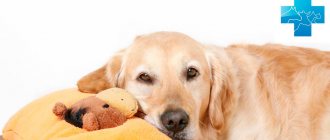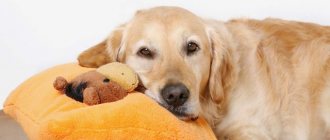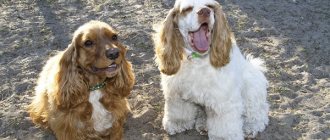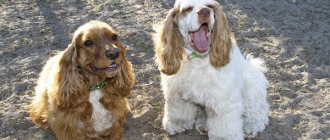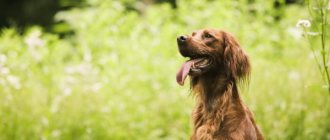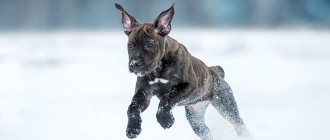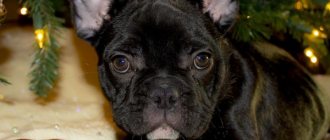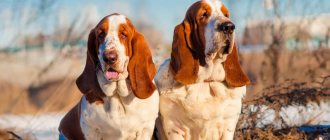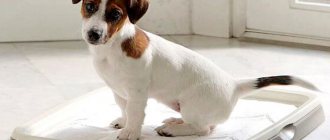Truly sweet and spontaneous creatures are spaniels. There is hardly a person who will remain indifferent to this beautiful and intelligent dog. Long ears add a special charm. They are the most vulnerable.
In this article I will describe the rules for caring for a problem part of the body. I'll tell you about the features of washing, cleaning, combing and cutting. I'll explain how to inspect and what to pay attention to. I will list the preventive measures necessary to maintain the health and beauty of your ears.
Features of caring for an elderly spaniel. How to properly care for an older spaniel?
An aging dog, like older people, requires special care. This way you can extend the years of your pet’s life and alleviate its condition. Spaniels begin to age from the age of 8 and after that they require especially close attention. Very often, signs of serious illness in older dogs are attributed to old age.
Reasons to visit a veterinarian at any age should be:
- thirst, lack of appetite and weight loss; - involuntary urination; - chronic diarrhea and vomiting; - general exhaustion; - limping; - inflammation of the gums; - difficulty breathing.
Features of caring for an elderly spaniel
The dog will not be able to complain to the owner that something hurts, so only close attention to your pet will allow you to identify the disease at an early stage. After 8 years of age, caring for a spaniel changes somewhat. The owner of the dog should make it a rule to take his dog for examination to the veterinarian every six months. It is necessary to do tests on a healthy dog, and then every time you visit a veterinarian. This is the easiest way to track changes in your pet’s body. Vaccination must be carried out annually, since the risk of disease in a long-lived spaniel is much greater. If the first symptoms of disease appear, you should not delay visiting the veterinary clinic, since it is always easier to treat diseases in the early stages.
Caring for your pet becomes more thorough. It needs to be combed regularly, distributing the produced oil evenly over the skin. Shampoos are not used for general purposes, but for skin diseases, and it is recommended to bathe the spaniel more often. While petting your pet, you can examine its fur and skin for the presence of ulcers and inflammations. These may be the first signs of tumors. The eyelids and gums are also examined. In normal condition they are pink.
A sudden change of environment for a retired spaniel is also not recommended. Dogs generally do not like change, and in old age it should go more smoothly. If you get a second dog, you try to give equal attention to both pets. There is no need to overload the body with games or long walks. If a dog begins to choke, this is a bad sign.
A special diet is also required. Nutrition must be balanced. When the dog begins to lose teeth, they switch to softer food. You should carefully monitor your weight. Not enough exercise and lots of treats can lead to obesity. And obesity in dogs usually ends with the heart simply not being able to beat due to fat…. Care and attention from the owner will best brighten up the spaniel's advanced years.
We invite you to watch a video about how to properly care for an elderly spaniel...
Basic steps
If the inside of the cavity is heavily overgrown with hair, then take nail scissors and cut off all the long hairs, opening the ear canal. Now you can assess the presence of sulfur deposits. If there are few of them, the skin is pale pink, then this time you can do without special cleaning.
How to clean your dog’s ears if you see that a lot of wax has accumulated? In this case, take a cotton pad, lightly moisten it with warm water and squeeze it thoroughly. There is no need to reach deep into the ear with a stick; you only remove what is visible. If in recent days you have noticed that your dog is scratching its ears, it makes sense to use special drops. However, be sure to consult your doctor.
Website about dogs
Cocker Spaniels are one of the most beloved and popular dog breeds in the world. Cute American and English cocker spaniels always attract attention at any exhibition. The variety of colors, characteristic “eared” appearance, cheerful and easy-going character of these dogs allowed them to win the hearts of thousands of dog owners around the world.
How difficult are spaniels to care for, and can this breed be recommended to novice dog breeders? We talk about the features of caring for cocker spaniels in this article.
Let's start with the most striking breed trait. Of course, these are the famous cocker spaniel ears. Long drooping ears give dogs of this breed an incredible resemblance to a soft toy. But do not forget that this is not only a funny detail of the exterior, but also a working organ responsible for the animal’s full auditory perception.
Dogs with long, drooping ears are more susceptible to various ear diseases. Spaniels often have otitis media, and they are more likely than other breeds to become victims of ear mites.
You shouldn’t be scared - this is just a tribute to the anatomical shape of the ear, tightly covering the entrance to the auricle. For a hunting dog (and all spaniels, including cockers, come from one ancestor - a tireless assistant on the hunt), such ears were a requirement. When working in the field and in reservoirs (they hunted waterfowl with spaniels), long ears protected the ear from possible ingress of water.
Nowadays decorative dogs do not have such a need, but the ears remain the signature highlight of the spaniel. And they require attention and special care. It should be understood that this form prevents ventilation of the ear, which leads to unpleasant consequences. If the owner of a husky or a German shepherd can look into the ears of their pet once a month, then the owners of spaniels need to do a preventive examination at least once every two weeks and clean their ears from plaque, if necessary.
You should definitely go to the vet if your dog constantly scratches his ear, shakes his head, or whines in pain.
Prevention is the best cure
The Spaniel's ears first of all need airing. A hanging position contributes to the accumulation of sulfur and the development of various infections. An additional factor is the overgrowing of the ear from the inside with hair. This provides ideal conditions for the development of pathogenic infections.
Therefore, it is recommended to carefully shave or pluck the inside of a spaniel's ears. If the pet is not accustomed to such procedures, then, as a last resort, you can cut the fur short with scissors.
Food allergies
Spaniels are great lovers of tasty food, which often manifests itself in excess weight and allergic manifestations. If you notice an abundance of dandruff, itching and scratching, perhaps it is not a new shampoo, but that your dog has an allergic reaction to a particular food product.
An important nuance: in dogs, food allergies are cumulative, that is, a dog can eat an allergen product for several months, and only later will it develop an allergy.
This makes it somewhat difficult to identify such a product and makes the recovery process slow. But you can still find such a product by eliminating potential threats from your dog’s diet one by one. First of all, you should pay attention to cereals (wheat, buckwheat, oatmeal) and chicken from the store. These products top the ranking of dog allergens.
In order not to guess, you can immediately switch your dog to dry hypoallergenic food - such food is available in the line of almost any brand.
From the love of food comes another threat to the health and even life of any cocker spaniel - overweight and obesity.
Excess weight in dogs is not only cute fat sides and a funny gait, it is also a fat-filled heart, liver, overloaded joints, ligaments, and spine.
Obesity is deadly for dogs. Therefore, if your pet begins to gain weight, this is not a reason to be touched - it urgently needs to be shown to a veterinarian. Most likely, if there are no pathologies, the problem is the excessive caloric content of food or its excessive quantity.
Adjust the dog’s diet, switch to lighter food (in ready-made dry and food you can choose food for sedentary dogs), cut down the portion, provide the dog with a sufficient level of physical activity.
These are the main points that every loving cocker spaniel owner should pay attention to. With proper care, these dogs live a long time.
Natural ventilation
There is another preventive measure available. The spaniel's ears can be raised above the head by securing them with a soft clip or hair tie. This is especially true during meals. If you do not do this, after a meal you will have to wash the outer and inner surfaces of the ear, and there is a high probability that water will get inside the auricle. This often leads to inflammatory processes.
Russian spaniel is the pride of domestic dog handlers
The Russian Spaniel is a gun hunting breed of dog. Its selection began at the dawn of the 20th century, when English cocker and springer spaniels were brought to Russia. The characteristic type of the breed was determined after the Great Patriotic War. And in 1951, the first standard of the Russian spaniel was adopted, which met the requirements of hunters in the USSR.
Price range
If a puppy’s exhibition and breeding career is planned, then the owners should expect a cost of 25-30 tr . If a puppy is purchased as a pet, the price varies from 8 to 20 thousand rubles.
A Cocker Spaniel will become your best friend, a companion in games, walks and travel, and will delight you for many years, provided it is properly maintained and well-educated.
Breed Features
This breed is popular in Russia, but remains unrecognized by the Fédération Cynologique Internationale (FCI).
Description of the Russian Hunting Spaniel – a hardy, persistent, active dog. This is a universal hunter of field, pine forest, and swamp game birds. Can dive and swim to retrieve an injured duck from the water. She has a sharp mind and good instincts.
Spaniels can be watchdogs, but developing these skills will harm their hunting ability.
The dog is devoted to the owner, ready to carry out all his orders. Obedient and easy to train. She definitely needs long walks with good physical activity. Otherwise, the pet may become hyperactive or become obese.
The Russian Spaniel has a friendly character. The breed is suitable for families with children. Gets along well with other pets, even cats. But you should be more careful if you have birds or small rodents. Still, no one has canceled the hunter's instinct.
This breed can be kept both in a city apartment, in a private house or on the street. They tolerate cold and heat well.
The Russian Spaniel is a medium-sized dog, squat, with well-developed muscles. The height of an adult is 38-45 cm (depending on gender), weight is 12-18 kg. Life expectancy is 12-15 years. The coat is medium length, straight or slightly wavy. The color can be either monochromatic or combine 2 or 3 colors.
Regular inspection
We have already mentioned that it is necessary to regularly examine the entire ear cavity. Before this, prepare cotton swabs and disks, warm water. Lay your pet on its side and caress it so that it lies quietly during the procedure. Now turn your ear completely inside out and inspect it carefully.
Since cleaning your dog's ears is not difficult, there is no need to contact the veterinarian every time. We offer you a general scheme, following which you can maintain their ideal condition.
Features of feeding
Up to 4 weeks, puppies eat only mother's milk. Depending on the type of content, the following is used for the first complementary feeding:
- natural type – minced meat, egg yolk (no more than 2 times a week), vegetables, dairy products;
- industrial type - soaked dry food.
Start with small portions, gradually increasing their size.
A puppy's food at 1.5-2 months should be of a fairly thick consistency.
To raise a healthy dog, you should not overfeed your puppy. But there shouldn’t be a shortage either. You may deprive it of essential nutrients, which can harm its development.
To keep him active and prevent his belly from becoming bloated, feed him in small portions, but often:
- from the moment of weaning from the mother and up to 3 months - 6 times a day;
- 3-5 months – 5 times;
- 5-9 months – 4 times;
- 9-11 months – 3 times;
- from 11 months – once.
Up to 10 months, the puppy is actively developing and needs more protein than an adult dog - 30-50 grams per kilogram of weight.
The total volume of food is 80-120 grams per kilogram of weight. It gradually decreases and by 12 months it can be 60 g/kg. The puppy should eat everything by licking the bowl. If food remains, then you are overfeeding him.
When you pick up a dog from a breeder, ask what type of feeding the puppy had. If you change it, the transition should be smooth within 1-2 weeks.
Pros of small breasts
In fact, if you think about it, you can find a lot of advantages of having small breasts, but I think even if you read these and think about them, you will realize that I am right!
- — Small breasts are very convenient!
Well, firstly, nothing bothers me when walking, and it doesn’t shake too much when jumping rope, which I do every day. In the summer, I don’t have all sorts of “troubles” under and around my breasts that often plague size 5 owners, don’t you agree?
- — A woman looks younger with small breasts
, doesn’t she? This is especially true after 30 years, when, thanks to only these natural data, you look young and beautiful, approximately a little older than a teenager. You just have to try a little: if you don’t have a great figure and a thin waist, immediately go to the gym and go on a diet (based on your blood type, for example).
- — I asked my husband a question about the breasts, and he answered me: “ When I see big breasts, it’s a nursing mother, and that’s all
. Why would I marry you then? When you’re young, everyone’s blood pounds in their temples when they see a really big size, and then their brains fall into place.” ABOUT!!! - — And I also started studying questionnaires and found out that small breasts react faster to caresses and touches
than large ones, well, what else do you need?
- - Finally, who was push-up invented for then
? Go out into the world, put on a bra, everything has been lifted and grown literally before your eyes. Here. Is it possible to hide large breasts somewhere? That's what I'm talking about.
Not convinced? And look at the breasts of Milla Jovovich, Natalie Portman, Keira Knightley and others, did that stop them?
Feeding an adult dog
The owner chooses the type of food for the spaniel. If the dog regularly goes hunting with its owner, then industrial food is a more convenient option. If field conditions are not expected, then natural food can be used. The main thing is that the combination of these two types should be excluded. This can lead to digestive problems.
An adult dog needs to be fed 2 times a day, an hour after a walk. The peculiarity of dogs of this breed is a tendency to obesity. Don't overfeed them.
Your spaniel should always have clean, unboiled water.
Industrial feed
Dry ready-made food or canned food is balanced and contains microelements and vitamins. Choose them carefully. The composition should not include dyes, preservatives, or unfamiliar components. A high content of herbal ingredients does not provide any benefit.
A pronounced aroma and uneven color are signs of low-quality food.
Do not buy dry food in bulk.
Natural diet
Eating natural foods allows you to track the occurrence of allergies.
If a Russian spaniel is kept on a natural diet, then it should additionally receive vitamin complexes. The veterinarian selects them.
The menu for an adult dog should include:
- meat and offal (2/3 of the diet) - beef, lamb, turkey, chicken (white meat), rabbit, horse meat;
- sea fish after heat treatment - hake, cod, haddock, halibut;
- chicken and quail eggs (in the absence of allergies);
- dairy products - cottage cheese, curdled milk, kefir, fermented baked milk, yogurt without sugar and fillers;
- cereals – rice, buckwheat, oatmeal, millet;
- oil – olive, pumpkin, unrefined sunflower;
- vitamin supplements;
- greens - parsley, dill, celery, lettuce;
- vegetables - carrots, zucchini, white cabbage, bell peppers, cucumbers, etc.;
- fruits, including dried fruits.
Food should be fresh, not hot or cold.
Food from your table is not recommended.
- sausages – contain preservatives and flavor enhancers;
- river fish – possibly containing helminths;
- sugar, chocolate and other sweets;
- pasta;
- spices, salt;
- pickled, smoked, fatty foods;
- tubular bones.
Returning from the hunt
If you often spend time outdoors, then your Cocker Spaniel's ears need more careful care and attention. The most important thing is to prevent moisture from entering the ear canal to minimize the likelihood of inflammation. The working dog swims into lakes and rivers to ensure the supply of game. If we can plug the ear canal with cotton balls while bathing, then the dog should maintain perfect hearing while hunting.
In order to protect the ears, it is recommended to carefully shave the inside of the fur and lubricate the entire skin with sunflower oil. This will prevent water from entering, but does not guarantee 100% protection. Therefore, after the end of the hunt, it is necessary to immediately perform a number of procedures:
- Carefully inspect the fur and ears for the presence of parasites.
- Dry the cavity using cotton balls.
Puppy care
By feeding on mother's milk, the puppy receives the necessary antibodies and develops immunity.
Make sure your baby is healthy and vaccinated when you pick him up from the breeder.
You can walk with your puppy only after all the necessary vaccinations. Train your spaniel to go to the toilet while walking. Praise him if everything worked out.
Start with walks in a quiet place, gradually increasing their duration.
Cleaning procedure
When returning home from a walk, you need to inspect your pet. Lay him on his side, pet him so that the dog lies calmly, then turn each ear inside out one at a time. If the skin inside is pink, warm, and clean, the examination can be considered complete. To clean dirty ends, wipe them with a soft damp cloth, then comb them.
You need to clean your spaniel's ears according to the following procedure:
- the long hair around the ear canal is trimmed. The passage itself is covered with a cotton swab during the haircut to prevent hairs from getting inside;
- Excess brown sulfur is removed with a cotton swab or damp cotton pad. For large dogs, it is more convenient to remove wax with a piece of gauze or bandage wrapped around a finger. For severe dirt, you can use a few drops of warm sunflower oil or dog ear lotion. A few drops of the product should be placed into the ear canal, and after 2-3 minutes, wipe dry with a dry cloth;
- After cleaning, veterinarians recommend using a special powder that disinfects and dries the ear canal.
Vaccination and veterinary medicine
The first vaccination for spaniels is given at 9 weeks. A few days before this, the puppy is rid of worms. After 1-2 weeks, vaccinations are repeated. Only 10-14 days after the second stage, you can go for the first walk.
At 6-7 months, after a complete change of teeth, the Russian spaniel undergoes the third stage of vaccination. Be sure to have a rabies vaccination - this is one of the most important vaccinations for a hunting dog.
At 12 months, the third stage is repeated.
Then the entire vaccination course is carried out once a year.
It is better to choose a veterinarian before the first vaccination and do not change it throughout the dog’s life.
On a walk
Representatives of this breed love to walk very much. Active games and exercises in the fresh air strengthen the immune system and normalize the functioning of all organs and systems. A spaniel's ears get very dirty when walking. The dog runs, pressing its curious nose to the ground, and long “canvases” dangle along the ground, collecting dust and microbes.
Coming home, any owner will try to clean his pet. A moistened but not completely washed ear becomes an ideal incubator for bacteria. Therefore, before going outside, make sure to fix your ears high on your head. To do this, you can come up with a headband made of soft elastic. The simplest option would be a piece of nylon stocking. It's quick, cheap, and great for keeping your ears clean.
Breeding
To be bred, a dog must meet all breeding stock requirements. A pair is selected only after passing operational tests and assessing the exterior.
There are breeders' clubs in every major city in Russia. Strict selection allows you to preserve and even improve the breed.
A Russian Spaniel will not be admitted to exhibitions if it has:
- problems with bite, teeth, lack thereof;
- different eye colors;
- aggression or cowardice;
- bobtail;
- weakly expressed differences by gender;
- absence of one or both testicles, their defects.
A deviation in height of 2 cm is considered a defect.
Grooming, cutting a Cavalier King Charles Spaniel
Correct grooming procedures: hygienic (bathing, combing, trimming nails and removing excess hair from paw pads, cleaning ears and removing excess hair, paranal gland hygiene, dental hygiene), carding, edging work. Sometimes used grooming practices in pet grooming: haircut
machine (combing out the shedding undercoat) is used if the dog has a thick shedding undercoat. In this case, a specialized tool is used - a double-sided rake and a trimming knife. Groomer works on hair growth. As a result, shedding hair is removed, and living hairs will adhere tightly to the dog’s body.
A distinctive feature of grooming a Cavalier King Charles Spaniel is that there is no need to trim the hair on the top of the feet and knees, or between the pads of the paws. The paws, only along the perimeter, are given an oval shape.
Need to remember
Each ear uses its own set of cotton pads, sticks and swabs. In addition, after treating one ear, it is advisable to change the solution in which you soaked the discs and wash your hands. This will prevent the infection from transferring from one ear to the other, provided that there is one.
After completing the procedure, be sure to wipe the inner surface of the ear dry and open the shell until completely dry. To do this, it is most convenient to use a mesh elastic band. Simply place it on your dog's head and tuck his ears under it.
The ideal option is to use a special powder after cleaning, which dries the surface well and removes remaining moisture. You can use a small amount of starch instead. But make sure that it does not fall into the ear canal.
